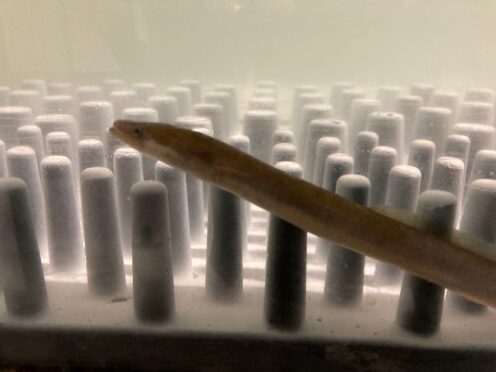
A new “cheap and easy” method could make swimming upstream easier for a critically endangered eel species when they arrive in the UK and help slow down population declines, scientists have found.
Each year, more than a billion European eels (Anguilla anguilla) travel 4,000 miles across the Atlantic to European shores.
But the creatures are still very young when they start navigating UK’s lakes and rivers, swimming against the flow of water to find feeding grounds – which requires significant energy and effort.
Human-made obstacles such as dams and weirs can make this even harder, sometimes by making rivers flow faster.

Scientists at Cardiff University believe the solution could lie in textured tiles which can slow down the flow of water, giving these ray-finned fish opportunities to rest and preserve energy while travelling.
They said the findings, published in the journal Ecological Engineering, could offer conservationists a new fish passage solution by helping reconnect UK’s rivers for these eels and potentially slowing down a population decrease.
Known as eel tiles, the studded structured are already being used to help them climb over obstructions.
But researchers found the tiles – which are cheap to buy and easy to install – could also be used in rivers where water velocity is high.
The team recreated fast-flowing river conditions in a huge water tank in a lab and found more eels passed through when the tiles were present.
They also found the fish used an asymmetric swimming technique that had never been seen before.
Lead author Guglielmo Sonnino Sorisio, a PhD student at Cardiff University’s School of Engineering, said: “We showed that fitting tiles to the bed of large water channels, designed to represent real river conditions, reduced flow velocity, enabling eels to successfully pass upstream using less energy in the process.”
He added: “It was surprising to see how well and how quickly the eels adapted their swimming techniques to the new environment.”
All European eels are born in the Sargasso Sea, on the other side of the Atlantic Ocean, and it takes them around three years to reach the UK.
Fewer than one in 500 larvae are thought to survive this long and challenging journey.
Mr Sonnino Sorisio said: “Juvenile eels migrating to fresh waters from the Sargasso Sea have so much to contend with, including shifting currents, polluted waters, chemical barriers, fishing pressures and disease.
“Our study tackles human-made physical barriers, which fragment, disconnect and reduce habitat availability for the species.
“These structures, built to support road crossings and prevent flooding, produce high velocity flows which make it hard for the young eels to swim through.”
The number of eels arriving in Europe has fallen by around 95% in the last four decades, with habitat loss, disease and climate change thought to play a role.
Study co-author Andy Don, from the Environment Agency’s National Fisheries Services team, said: “There are several reasons for the decline.
“Barriers in water courses and stillwaters are a major factor in preventing eels from reaching freshwater habitat where they can thrive and grow.
“There are approximately 23,000 obstructions in England, 18,800 of which are man-made.
“The consequence of these fragmented systems on upstream migration is that iconic and valued freshwater fish species, including eels, require solutions to allow them to overcome barriers and maximise habitat use.”
The eels will spend most of their lives in the UK’s freshwater habitats before making one last journey back to the Sargasso Sea to breed, and then die.
The research was carried out in collaboration with the Environment Agency and Natural Resources Wales.

Enjoy the convenience of having The Sunday Post delivered as a digital ePaper straight to your smartphone, tablet or computer.
Subscribe for only £5.49 a month and enjoy all the benefits of the printed paper as a digital replica.
Subscribe